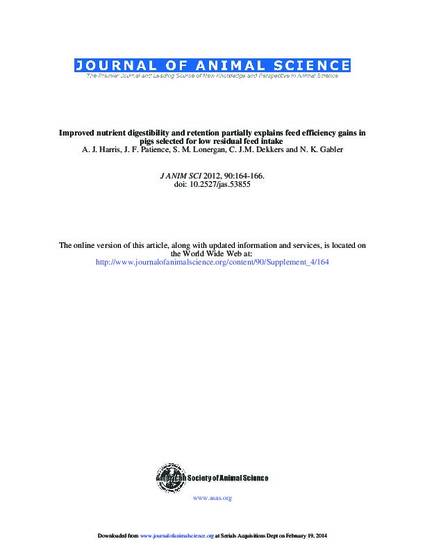
Residual feed intake (RFI) is a unique measure of feed efficiency (FE) and an alternative to traditional measures. The RFI is defined as the difference between the actual feed intake of a pig and its expected feed intake based on a given amount of growth and backfat. Therefore, selecting pigs with a low RFI (LRFI) results in a more feed-efficient animal for a given rate of growth. Our objective was to determine the extent to which apparent total tract digestibility of nutrients and energy use and retention may explain FE differences between pigs divergently selected for LRFI or high RFI (HRFI). After 7 generations of selection, 12 HRFI and 12 LRFI pigs (62 ± 3 kg BW) were randomly assigned to metabolism crates. Pigs had free access to a standard diet based on corn (Zea mays) and soybean (Glycine max) meal containing 0.4% TiO2, an exogenous digestibility marker. After a 7-d acclimation, total urine and feces were collected for 72 h. Nutrient and energy digestibility, P digestibility, and N balance were then measured and calculated to determine differences between the RFI lines. As expected, ADFI was lower (2.0 vs. 2.6 kg; P < 0.01), ADG did not differ, and FE was higher in the LRFI (P < 0.001) compared to the HRFI pigs. The digestibility values for DM (87.3 vs. 85.9%), N (88.3 vs. 86.1%), and GE (86.9 vs. 85.4%) were higher (P ≤ 0.003) in the LRFI vs. HRFI pigs, respectively. The DE (16.59 vs. 16.32 MJ/kg DM) and ME (15.98 vs. 15.72 MJ/kg DM) values were also greater (P < 0.001) in LRFI pigs. When correcting for ADFI, P digestibility did not differ between the lines. However, the LRFI pigs tended to have improved N retention (P = 0.08) compared to HRFI pigs (36.9 vs. 32.1 g/d). In conclusion, the higher energy and nutrient digestibility, use, and retention may partially explain the superior FE seen in pigs selected for LRFI.
Available at: http://works.bepress.com/john-patience/45/

This article is from Journal of Animal Science 91 (2012): 164–166, doi:10.2527/jas.53855.